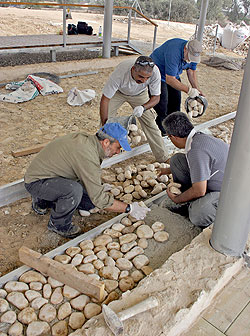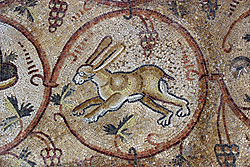One of the Most Spectacular Mosaic Floors Ever Discovered in Israel was Restored and Renovated and Can Now be Seen by the General Public (30/3/09)

The 1,500 year old (!) mosaic is in the ancient synagogue at Ma‘on-Nirim
The mosaic, which is decorated with a seven-branched candelabrum and images of different animals, was conserved and returned to its original location. The site is now open to the general public and admission to it is free.
The site of the mosaic floor, which is part of a synagogue from the Byzantine period (fifth and sixth centuries CE), is located in the settlement of Ma‘on-Nirim, in the western Negev, and will be open to the public this week. This mosaic originally measured 3.70 x 7.80 m but was damaged when the road to Kibbutz Nir Oz was paved in 1957. The mosaic floor and the remains of the synagogue were discovered during salvage excavations that were undertaken on behalf of the Department of Antiquities in 1957. The mosaic’s state of preservation has deteriorated in recent years as a result of the unsuitable conditions in which the mosaic was kept and a lack of maintenance. Therefore, in 2006, it was removed from the site and transferred for treatment to the Conservation Laboratories in the Rockefeller Museum in Jerusalem.

The Jewish National Fund, Israel Antiquities Authority and Eshkol Regional Council cooperated in implementing the rehabilitation project. The JNF assisted in the renovation of the synagogue and a generous contribution by Sandy Galet was used to fund the tourism development work which included: signage, access roads, walking paths with access for the handicapped and a new entrance to the site via Highway 232. Future development plans for the site include a picnic area and walking paths in the nearby forest. The conservation work on the mosaic and the archaeological remains of the ancient synagogue was carried out by a team of mosaic conservators from the Conservation Department of the Israel Antiquities Authority.
On Monday, March 30, 2009, at 11:00 AM, a ceremony will take place during which the mosaic will be unveiled and the site will be inaugurated. The ceremony will be attended by Mr. Effi Stenzler, Chairman of the JNF; Mr. Shuka Dorfman, director of the Israel Antiquities Authority; and Mr. Haim Yellin, head of the Eshkol Regional Council.
The site is open to the general public and admission is free.

The Conservation Method
The process of detaching the mosaic from its foundation included documentation, cleaning, and gluing the surface of the mosaic to cloth. Part of the mosaic was separated and rolled onto a wooden drum that was prepared for this purpose and the rest was removed in pieces c. 1.5 meters in size. The team of conservators from the Israel Antiquities Authority cleaned the remains of the old bedding from back of the mosaic and returned the mosaic to its original location atop the new foundation (consisting of lime-based plaster) that was prepared for it.
On the Mosaic Floor
According to the archaeological findings the northern wall of the synagogue’s sanctuary was breached in the middle of the sixth century CE and an apse, which is a circular niche that protrudes outward, was installed in the opening. The level of the earlier floor was raised and a breathtakingly beautiful mosaic floor surrounded by marble columns was constructed on top of it in the northern part of the sanctuary. The synagogue had a basilica plan in which there was a nave with a mosaic floor that was flanked by two aisles paved with stone tiles. The ceiling was built of wooden beams and clay. The decoration on the mosaic floor consists of a vine tendril that stems from an amphora to form a trellis of medallions that are adorned with scenes of everyday life from the vineyard and from wine production and with different animals. The images portrayed in the upper rows include a seven-branched candelabrum that stands on three legs shaped like lion’s feet, and near them etrogim, a shofar and a lulav, and alongside the candelabrum – palm trees and lions, which are symbols of Judah. An Aramaic inscription is incorporated in the mosaic. The upper part of the inscription blesses all of the community followed by a dedication to three individuals who donated generous contributions.

Tiny objects were found on the floor facing the Holy Ark: coins, bone and metal artifacts that probably belonged to the Holy Ark and the ornamental curtain in front of the Ark, as well as fragments of glass and ceramic lamps. Also found were dozens of amulets, some of which were of women who were asking for good health.
The Ma‘on synagogue is located in the Hellenistic site of Menois, which appears on the Madaba Map. It is one of the three synagogues in the western Negev and its floor is identical to the one in the synagogue in Gaza. The site, which was one of the most important tourism sites in the western Negev, had been allowed to deteriorate over time.
Photographic credit – Niki Davidov, courtesy of the Israel Antiquities Authority.
Additional Articles ...
Archive